 | Work-packages
|
|
The work has been broken down in 7 Work Packages with the following respective objectives.
| WP1 | Global
System Modelling
Leader: 2.-0 LCA |
|
WP 1 will provide the model for calculating material stocks, waste quantities and environmental indicators at the most global level.
The model to be applied is an environmentally extended, physical, quasi-dynamic input-output model, covering the EU-27.
The model is based upon the most detailed of the currently available environmentally extended economic input-output matrices (IO-tables) based on the national accounting systems (also known as National Accounting Matrices with Environmental Accounts or NAMEAs). The lead partner for this WP has previously developed detailed, environmentally extended IO-matrices for the EU-25 and for individual EU-countries.
The will be improved in several iterations, throughout the project:
 |
Initially, the model coefficients will be based on readily accessible data, as described above,
|
 |
As part of WP2, a data quality assessment will be performed on the initial model coefficients, resulting in a data collection strategy for WP 3 and 4, with the aim of reducing the most important uncertainties in the initial model coefficients. The data quality assessment will involve assessments of the variation in coefficients between different countries and data sources.
|
 |
WP 3 and 4 will identify and calibrate additional data sources for application of the model across EU-27 as well as for specific countries with high quality statistics.
|
 |
In WP 6, the data collected in WP 3 and 4 will be applied in the model, further calibration will be made, waste treatment models from WP5 will be added, and the final model will be applied to the different scenarios of waste prevention, treatment and recycling defined in WP5.
|
|
| WP2 | Data
Identification and Management
Leader: RMA |
|
This work-package will provide the required data definitions and guidelines to achieve the strategy for data acquisition. The system will be developed using Material Flow Analysis (MFA) nomenclature and procedures. The MFA methodology allows a representation of the complex reality in flows, processes and stocks (whereas stocks are treated as processes). It allows a mapping of the entire economy with most important flows and processes. These are flows which result in high mass flows, in high consumption of natural resources, large stocks and large environmental pressures. This work package is linked to WP1 and intense interaction is
foreseen.
To maintain the system clear and concentrated on the objective, it is necessary to set system boundaries, spatial and temporal for each data collection exercise. The definition of the system (boarders, processes, flows, stocks) and the selection of appropriate materials is conducted using the system model of WP1. The reporting of anthropogenic stocks is a particularly important issue considering it’s use as a secondary resource in the future and/or endangering the environment. As the assessment of stocks is very sensitive an own task is dedicated to the methodology of stock
mapping.
To ensure the usability of the defined system for data acquisition, a handbook will be produced for the consortium. It will ensure a homogenous coordinated carrying-out of all
case-studies.
|
| WP3 | In-depth
data mining
Leader: U. Stuttgart |
|
The objective of WP3 is to obtain secure data for four specific countries (Germany, Austria, Denmark and France), where reliable statistics are available. In the three former countries, it is expected to have reasonable agreement on terms and waste management logic. In the latter, it is expected to have to cope with different systems for waste statistics, nevertheless rather well documented. In the following figure the methodology within WP3 is summarized.
The output from the previous working packages (WP1 and WP2) will be – among others – the identification of the relevant materials / products for the analysis of the national and European statistics. Another important output from WP1 and WP2 is the definition of terms to ensure that every partner of the consortium is “talking the same language”. Finally, the system boundaries need to be defined, in order to establish up to which level (depth) data will be collected.
The results from WP1 and WP2 will give an indication of which kind of data will be collected within WP3. The methodology of data mining in WP3 contains the following main steps:
 |
Starting workshop for harmonisation and knowledge transfer from WP1 and WP2 to WP3
|
 |
Definition of data structure (data bases)
|
 |
Collection of statistics in Germany, Denmark, Austria and France
|
 |
Comparison and verification of the required data postulated in WP1 and WP2, especially regarding the identified relevant materials / products, with the available data in national statistics
|
 |
Identification of missing data
|
 |
Collection / substitution of missing data from individual sectors
|
 |
Check for plausibility and data reconciliation
|
 |
Elaboration of Coefficients and Indicators in relation with WP5 (transfer coefficients, mathematical descriptions of dependencies)
|
 |
Identification of potentials and difficulties for completing data collection (holders, economic constraints, scientific lacks, etc.)
|
The results from WP3 are the elaborated databases with validated data and coefficients for the four mentioned countries. From these, the future stocks and waste streams can be forecasted. Apart from that, the eventual need of further investigations and research activities will be identified. The databases will be available in ELCD format to feed the JRC Ispra European platform on
LCA.
|
| WP4 | Coverage
data mining
Leader: GIG |
|
This work package intends to collect data in a perspective of broad coverage of the EU territory. As most uncertainties reside in the data for the new EU10, this work package will focus on these countries, which will be covered by GIG. The second priority effort will concern the southern countries, which will be covered by University of Thessaloniki. BRGM will profit from its current projects in Romania to bring its possibilities of data drainage for the consortium and will also be responsible for data from Bulgaria. The main data needs will be identified by WP1 and WP2 and will help the data mining partners to focus on relevant data sources.
Nevertheless, the data mining on resources flows, emissions, product flows and waste generation and management for the considered sectors of economy will also consider more global statistics of the nations and try to figure out their relevance.
WP4 will be conducted in two steps:
 |
collecting and compiling data from different sources: national and European statistics as well as other available sources,
|
 |
analyzing and validating compiled data; identifying gaps; results will be consulted and evaluated by key stakeholders representing authorities of each country.
|
All data will be streamlined transmitted to WP5 for further analysis and feed-backs.
|
| WP5 | Scenario
and waste technology definitions
Leader: TU Vienna |
|
WP5 represents the forecasting exercise of the project. It is intended to define the frame for the analysis of the effects of waste policies on reaching the goals of waste management (Council Directive 91/156/EEC on waste), namely protection of men and the environment, and resource conservation. The forecasting method proposed is based on scenario definition. Two axes will be included in the development of scenarios: Waste policies such as prevention, recycling and disposal on one hand, and main drivers such as market evolution, cycles of economic development, and technology development on the other hand. The later issue will involve the participation of the Steering Committee, too.
The guiding principle for the elaboration of scenarios will be to cross policy options for waste management and macro-economic hypotheses. As a baseline, recent macro-economic scenarios for the EU-27 countries until 2035 will be reviewed, and three different macro-economic scenarios will be defined (e.g. a base-line option, assuming no change in policy, and with some exogenous economic drivers (population forecasts, etc.). Concerning policy options for waste management, three (“what-if”) strategies favouring prevention, recycling and disposal each will be selected. These strategies will be compared to the status quo development. Based on the results of the comparison, finally a so called “optimised” scenario will be developed that intends to combine the benefits of the three strategies in order to establish a scenario that reaches the goals of waste management (protection of environment, resource conservation) in an optimum way.
The resulting scenarios, combining macro-economic hypothesis and waste policies are discussed and determined in consultation with the Steering Committee. The dependencies of the different processes involved on waste policies will be highlighted so that they can be used to feed the global model in WP6.
|
| WP6 | Forcasting,
Assessments and Interpretation
Leader: 2-0 LCA |
|
This workpackage gathers the information from the 5 previous workpackages in order to provide a 25 year forecast of the cumulated physical stocks and waste generation for EU-27, as well as the corresponding environmental impacts from the different scenarios of waste prevention, waste treatment and recycling.
Data from WP2, 3 and 4 are integrated into the model from WP1 and a data consolidation and calibration exercise is performed and documented. Also the waste treatment and recycling processes from WP 5 are integrated into the model. This gives the map of the present situation.
Model simulations are performed with the nine scenarios from WP5 in order to provide the 25-year forecasts of the cumulated physical stocks, waste generation, and environmental impacts. Environmental impacts will be expressed both as environmental indicators per midpoint impact category and as aggregated, monetarised values, based on the most recent impact assessment methods. Similar results are calculated for the 4 specific countries for which data are collected in WP3. The principle of the monetarisation of mid-point impact categories lies in their conversion into damage categories, whose “costs” are estimated according to different techniques of cost/benefits analysis (direct
monetarisation) or through a more universal approach searching equivalence between damages
(QALY). These approaches have been developed mainly through health studies. They are still developing trough research projects and the FORWAST team intends to beneficiate from the last up-to-date methods at the time of the assessments.
The model results are analysed and documented in terms of contributing processes, materials and waste flows.
As a special attention to “mapping”, the matrices will be obtained for different regions or countries. These matrices can be linked. Thus, the EU technosphere can be constructed by linking the matrices of the individual EU countries for a given year. If some imports or exports are not specified by country, these can be linked to an additional matrix representing a trade pool, which receives all unspecified exports and from which unspecified imports are drawn.
An uncertainty assessment is carried out and documented. The uncertainty analysis will discriminating between the sensitivity of the system to the quality of data, to the lacks in understanding the causes of non coherence in the material balance, and to the influence of the life-time of stocks.
On the basis of the scenarios results, priority material flows and priority wastes for waste prevention, recycling and choice of waste treatment options will be identified on a national and European scale. The different policy options, instruments and technologies will be described and policy recommendations given.
|
| WP7 | Dissemination,
communication and valorisation of results
Leader: BRGM |
|
The content related part of this STREP proposal will be supported by the second horizontal WP7 on Dissemination, communication and valorisation of results. The communication plan is mainly led by BRGM but will naturally involve all project partners and the Steering Committee. Utilisation of knowledge is known to be confronted with distribution problems. It has been argued that more intensive communication via a number of different media would increase utilisation. However, it has been shown that other aspects play an important role in utilising knowledge. These have to do with the potential user of the knowledge, for example the user’s interest in it, the acceptability of the knowledge within the user’s context, and the complexity of the knowledge offered. It is essential to use as much as possible the national networks of the partners involved and Steering committee. Consequently a 4-task approach has been chosen for WP7:
Task 1. Relations with key actors for decision and policymaking;
Task 2. Providing information via various media and at numerous occasions;
Task 3. Use of existing tools at national/regional/local levels to ensure wide dissemination of the STREP results;
Task 4. Events: Apart from the project meeting and attendence of relevant conferences, seminars etc the organisation of an international workshop on EC Waste and Resources Policy is foreseen in Brussels. At an early stage (month 3) the expected attendance will be defined.
|
|
|
|
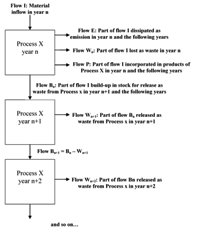
|
|
Figure 1. Schematic presentation of the flows arising from the inflow of a material to a specific production or consumption process.
|
|
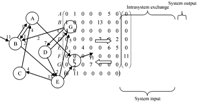
|
|
Figure 2. Generalized material flow accounting framework |
|
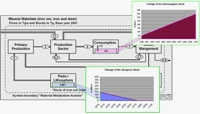
|
|
Figure 3. Example of a systems definition and a MFA for iron/steel for Austria
|
|
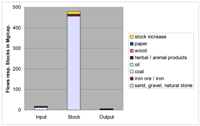
|
|
Figure 4. Example of the anthropogenic stock of Austria and the most important resources, that shows the importance of a future management of the stocks |
|
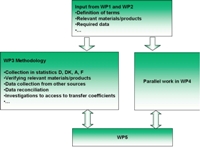
|
|
Figure 5. Methodology for WP3 (summary) |
|


